How strange to be on holiday after so long… We are very fortunate that the area we live in is so beautiful, a wonderful coast and great access to walks in the countryside from our doorstep, but after months of semi-confinement we needed a change and Yorkshire felt far enough away to tick all the boxes. It’s a county we have visited many times and we were there in March 2020 as the country started to close down so it felt apt to close the circle with a visit that wouldn’t get truncated this time!
I find it hard to be away from the sea so our first stop, Whitby, was one I was very much looking forward to. It was our third visit to Whitby and it’s certainly a town of contrasts. During the day it’s full of day-trippers, there are long queues outside the fish and chip shops and the pavements are bustling with tourists and seagulls with an eye out for opportunity. The pavements and everything standing on it, including us, are in constant danger of being showered with seagull “guano” to put it politely. On the other side of the River Esk from the chip shops tower the gothic ruins of Whitby Abbey and alongside is St Mary’s Church, surrounded by ancient gravestones. These two landmarks can be seen for miles, as we discovered when we walked the coastal sections of the Cleveland Way. The sands of Whitby are, of course, where the doomed ship Demeter, containing only one survivor, Count Dracula, runs aground and Dracula, in the form of a dog, races up the 199 steps to the Abbey.

You can find out more about Bram Stoker’s connections with Whitby here:
https://www.english-heritage.org.uk/visit/places/whitby-abbey/history-and-stories/dracula/
Stoker wasn’t the only writer to be charmed by Whitby. Lewis Carroll also loved to stay in the town and the house which was one of his favourite haunts is now a themed hotel, the La Rosa Hotel, with each room reflecting one of the town’s famous inhabitants. It is thought that Carroll might have composed The Walrus and the Carpenter while walking along the sandy beaches of Whitby.

Whitby also has connections with Captain James Cook who was apprenticed to a draper in Staithes and it was there that he fell in love with the sea. He later moved to Whitby as a trainee in a local fishing firm. He charted the coast of New Zealand and the eastern coast of Australia, a meticulous surveyor as well as a fine sailor and intrepid explorer.
Beyond the chip-strewn streets of Whitby, nestling in quirky streets above the town, there are many independent shops and even a French bistro or two! There’s also a wonderful heritage sculpture trail featuring life-size sculptures by local artist Emma Stothard. My favourites were Dora Walker, one of the first female skippers:

and the herring girls on the quayside:

In a way, the sculptures and their themes reminded me of Norfolk and home. The herring girls would follow the fishing fleets up and down the East coast of the United Kingdom and Great Yarmouth has strong connections with these women too. Emma Stothard sculpts using wire, and has also made some stunning willow sculptures. Seeing these figures set against seascapes reminded me of the the Lifeboat Horse sculpture at Wells-next-the-Sea, made from steel bars and whisky barrels. It was created by artist Rachael Long as a tribute to the horses that once pulled the town’s lifeboat more than two miles from the quay to Holkham Gap. I think the past fifteen months of uncertainty and limited travel have given me a stronger sense of “home” and I could feel its pull however much I was enjoying being away.

 The coast path which forms part of the Cleveland Way and which runs from Saltburn to Filey is stunning. We had done the Filey to Scarborough section in 2019 on my birthday in November so we focused on Saltburn to Scarborough and completed it in four stages – Saltburn to Staithes, Staithes to Whitby, a circular walk from Whitby to Robin Hood’s Bay (outward on the coast path and back on the Cinder Path, following the old railway line) and, finally, the biggie, Scarborough to Robin Hood’s Bay. The latter was definitely the most challenging, lots of steep steps up and down the crevices in the cliffs and lots of steep walks as the cliffs got higher.
The coast path which forms part of the Cleveland Way and which runs from Saltburn to Filey is stunning. We had done the Filey to Scarborough section in 2019 on my birthday in November so we focused on Saltburn to Scarborough and completed it in four stages – Saltburn to Staithes, Staithes to Whitby, a circular walk from Whitby to Robin Hood’s Bay (outward on the coast path and back on the Cinder Path, following the old railway line) and, finally, the biggie, Scarborough to Robin Hood’s Bay. The latter was definitely the most challenging, lots of steep steps up and down the crevices in the cliffs and lots of steep walks as the cliffs got higher.
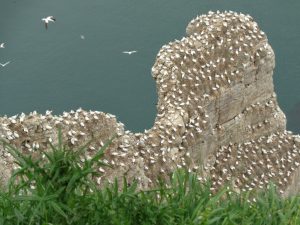
Between the Abbey and Robin Hood’s Bay we discovered Kittiwake City – a cliff full of the strange cries of the colonising kittiwakes. This discovery was somewhat trumped by a visit to the RSPB reserve of Bempton Cliffs where we discovered Gannet City. Over 11,000 breeding pairs of gannets have colonised these steep cliffs and there are puffins, guillemots, razorbills, kittiwakes and fulmars too.
We didn’t manage to fit in a steam train trip on the brilliant North York Moors Railway this time, but we did go through Grosmont on the “ordinary” train on the day Harrison Ford was there reprising his role as Indiana Jones for his next film. We had no idea as we sat, masked up, while our train rested a while in the pretty station, that we were so close to Hollywood stardom…
For our second week we chose Hawes in beautiful Wensleydale as our base. No coast nearby but plenty of rivers and waterfalls! One of our first walks was to Hardraw Force, a single drop waterfall of around 100 feet which very much impressed Wordsworth. He wrote to Coleridge in 1799:
Writing to Coleridge in December 1799 he says;
“Twas bitter cold, the wind driving the snow behind us the the best style of a mountain storm. We soon reached an inn at a place called Hardraw, and descending from our vehicles, after warming ourselves by the cottage fire, we walked up the brookside to take a view of a third waterfall, . . . . .
We walked up to the fall; and what would I not give if I could convey to you the feelings and images which where communicated to me?
After cautiously sounding our way over stones of all colours and sizes, encased in the clearest water formed by the spray of the fall we found the rock, which had before appeared like a wall, extending itself over our heads like the ceiling of a huge cave, from the summit of which the water shot directly over our heads into a basin, and among the fragments wrinkled over with masses of ice as white as snow, or rather, as Dorothy said, like congealed froth. The water fell at least tens yards from us and we stood directly behind it.”

Wordsworth greatly admired Turner’s sketches of the Fall. Turner stayed in Hardraw for three days completing four drawings of Mossdale Head, and two sketches of Hardraw Force one of which he worked up into the finished painting now hanging at the Fitzwilliam Museum in Cambridge. I’m guessing he probably stayed in the wonderful Green Dragon Inn where I discovered some great local beers. The Inn’s sign is fabulous, straight out of Tolkein.
Hardraw Force has another claim to fame for it was here that Kevin Costner, as Robin Hood, bathed naked in the Falls, just as Maid Marion and her entourage passed by. I celebrated this bit of Hollywood trivia by going behind the Falls fully clothed:
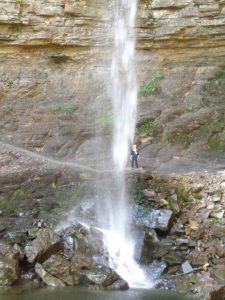
It was a beautiful time to be in the Dales. The area is known for its hay meadows and we passed through many of these on our walks. I kept a poetic diary of some of our walks, it’s such an inspiring area…
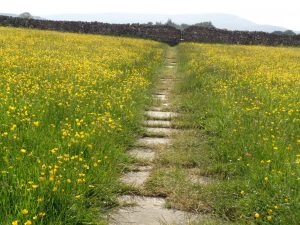
“fields awash with buttercups —the spilled gold of an English June”
On our final evening we hiked across the fields past Haylands Bridge for a sheepdog demonstration by local farmer Richard Fawcett, who is a bit of a celebrity for his role as a judge in international sheepdog trials and also for his TV appearances. Sheepdog matriarch Lola was having physiotherapy for a bad back so she couldn’t join in the whole demo (she was named for the Kink’s song), but her sons Keef (named after Keith Richards) and Croft, did her proud. It was a great evening – below is a shot of Richard lecturing his sheep on how to behave when there are people watching. Up on Dodd’s Fell on one side of the valley, and Stags Fell on the other, we had passed flock after flock of sheep, not realising that they were all owned by Richard and his brother. I am full of admiration for these farmers and their tough lives.

“A skylark’s explosive song crackles in the blue air; sheep stare, wondering how they have conjured us from grass.”




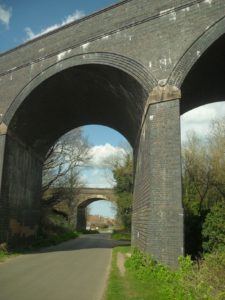

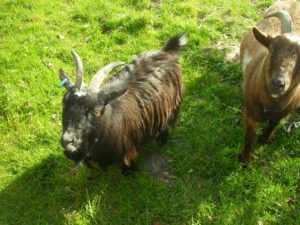 Down the green lane to the pygmy goats. These are hilarious. I seem to have perfected some kind of fake Swiss yipping yodel which brings them running, bells clanking and I can get them to follow me along the fence line to the next gate. The goat whisperer!
Down the green lane to the pygmy goats. These are hilarious. I seem to have perfected some kind of fake Swiss yipping yodel which brings them running, bells clanking and I can get them to follow me along the fence line to the next gate. The goat whisperer!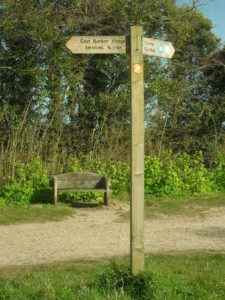
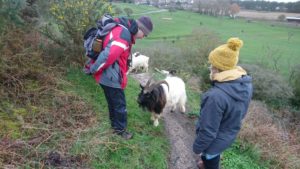




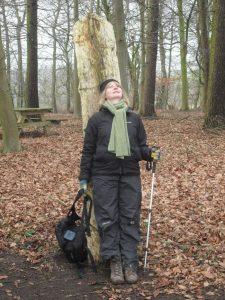

 Somehow, though, as we mature, many of us lose our way and poetry becomes something alienating and elitist, seeming to belong to an academic world of closely guarded secrets which only the chosen few can access. I would say that poetry belongs everywhere, to us all, to the world and, although it has a commercial motivation, I’m delighted that the Nationwide Building Society are using poetry to speak to their wide-ranging potential customer base. At the moment I’m following a course run by the Poetry School and tutored by Emma Hammond. It’s called Hyperspectacle and we’re exploring poetry which occurs in unexpected places – tweets, internet review forums etc I feel quite evangelical about getting more and more people to enjoy poetry, to realise that they can’t like it all, and if they don’t it’s not their fault but to keep on looking until they find something that speaks to them. There’s so much poetry out there at the moment, but it’s a bit like a dating website, you have to persevere to find your match!
Somehow, though, as we mature, many of us lose our way and poetry becomes something alienating and elitist, seeming to belong to an academic world of closely guarded secrets which only the chosen few can access. I would say that poetry belongs everywhere, to us all, to the world and, although it has a commercial motivation, I’m delighted that the Nationwide Building Society are using poetry to speak to their wide-ranging potential customer base. At the moment I’m following a course run by the Poetry School and tutored by Emma Hammond. It’s called Hyperspectacle and we’re exploring poetry which occurs in unexpected places – tweets, internet review forums etc I feel quite evangelical about getting more and more people to enjoy poetry, to realise that they can’t like it all, and if they don’t it’s not their fault but to keep on looking until they find something that speaks to them. There’s so much poetry out there at the moment, but it’s a bit like a dating website, you have to persevere to find your match!





 I’ve just returned from my second Arvon course under the Arts Council grant, this time at Lumb Bank, an imposing eighteenth century mill owner’s manse glowering down a steeply wooded hillside to where the ruined mill chimneys can still be seen. The concept of Arvon, the grandaddy of UK creative writing courses, was founded in Devon by poets John Moat and John Fairfax in l968 as a reaction against what they saw as a staid, dogmatic approach to teaching poetry. Lumb Bank was Ted and Carol Hughes’ home for a short while and was leased to Arvon when Hughes suggested it was time to open a Northern centre. The Arvon formula is the same in all three centres: two tutors, a guest reader mid-week and up to 16 anxious but starry-eyed participants. Fantastic poets and tutors Jean Sprackland and Jacob Polley had fun with an ever-changing good cop/bad cop formula and knocked us all into better shape with grace, sensitivity and humour, coaxing (or, perhaps, ripping!) seven very different poems out of me in just four days. Sean Borodale arrived on Wednesday night for his guest slot looking like a floppy-haired 21st century version of Keats to read his profound and erudite poems on subjects ranging from peeling and stewing apples to an extraordinary contemplation of a queen bee…
I’ve just returned from my second Arvon course under the Arts Council grant, this time at Lumb Bank, an imposing eighteenth century mill owner’s manse glowering down a steeply wooded hillside to where the ruined mill chimneys can still be seen. The concept of Arvon, the grandaddy of UK creative writing courses, was founded in Devon by poets John Moat and John Fairfax in l968 as a reaction against what they saw as a staid, dogmatic approach to teaching poetry. Lumb Bank was Ted and Carol Hughes’ home for a short while and was leased to Arvon when Hughes suggested it was time to open a Northern centre. The Arvon formula is the same in all three centres: two tutors, a guest reader mid-week and up to 16 anxious but starry-eyed participants. Fantastic poets and tutors Jean Sprackland and Jacob Polley had fun with an ever-changing good cop/bad cop formula and knocked us all into better shape with grace, sensitivity and humour, coaxing (or, perhaps, ripping!) seven very different poems out of me in just four days. Sean Borodale arrived on Wednesday night for his guest slot looking like a floppy-haired 21st century version of Keats to read his profound and erudite poems on subjects ranging from peeling and stewing apples to an extraordinary contemplation of a queen bee…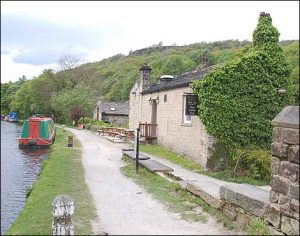 The weather was glorious except for the day I had cooking and washing up duty (sometimes the best-laid plans actually work out!). I did a daily walk down to Hebden Bridge to sit by the canal with a beer at Stubbings Wharf or a coffee at The Den watching the sun on the painted barges and dodging the hissing geese before the steep walk back up via Heptonstall.
The weather was glorious except for the day I had cooking and washing up duty (sometimes the best-laid plans actually work out!). I did a daily walk down to Hebden Bridge to sit by the canal with a beer at Stubbings Wharf or a coffee at The Den watching the sun on the painted barges and dodging the hissing geese before the steep walk back up via Heptonstall.  Sylvia Plath is buried in the new graveyard in this village which is a fifteen-minute walk from Lumb Bank. I’ve been to this area quite a bit and was glad that I’d already “done” my Sylvia Plath poem some years back – it’s hard not to be influenced by these two extraordinary poets and hard not to let the beauty and harshness of nature overwhelm your poems. There was even a cat called Ted, although it was from the farm down the road and turned out to be a girl…
Sylvia Plath is buried in the new graveyard in this village which is a fifteen-minute walk from Lumb Bank. I’ve been to this area quite a bit and was glad that I’d already “done” my Sylvia Plath poem some years back – it’s hard not to be influenced by these two extraordinary poets and hard not to let the beauty and harshness of nature overwhelm your poems. There was even a cat called Ted, although it was from the farm down the road and turned out to be a girl…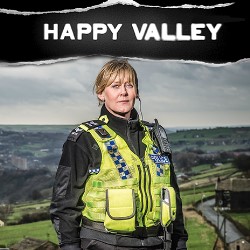 I discovered that one of the participants on the course had stayed in the same cottage in Mytholmroyd last April that Chris and I had rented in November during my birthday week. One of my presents was the first series of Happy Valley – it was a rainy week and we couldn’t stop watching it. Sally Wainwright’s flawless script, superb acting from a wonderful cast, particularly Sarah Lancashire and James Norton, and the fact that every night we walked along the dark canal back from Hebden Bridge to Mytholmroyd, passing the exact spot where the chillingly psychopathic Tommy Lee Royce had been hiding, all added to the dark and rather magnificent claustrophobia which permeates the Calder Valley on winter days. Sally Wainwright went to school in Sowerby Bridge and most of her scripts touch on this area (Sparkhouse, Scott and Bailey, Unforgiven etc) and, of course, Catherine Cawood, Sarah Lancashire’s character in Happy Valley, is often seen in Heptonstall at the graveside of her daughter Rebecca who is the invisible motivating factor behind the whole series. Calderdale has been used as a feature film location since Cecil Hepworth’s Helen of the Four Gates in 1920 and, with its sinister moor and heathlands, steep climbs, cobbled villages and solid stone buildings, it never fails to be a character in its own right.
I discovered that one of the participants on the course had stayed in the same cottage in Mytholmroyd last April that Chris and I had rented in November during my birthday week. One of my presents was the first series of Happy Valley – it was a rainy week and we couldn’t stop watching it. Sally Wainwright’s flawless script, superb acting from a wonderful cast, particularly Sarah Lancashire and James Norton, and the fact that every night we walked along the dark canal back from Hebden Bridge to Mytholmroyd, passing the exact spot where the chillingly psychopathic Tommy Lee Royce had been hiding, all added to the dark and rather magnificent claustrophobia which permeates the Calder Valley on winter days. Sally Wainwright went to school in Sowerby Bridge and most of her scripts touch on this area (Sparkhouse, Scott and Bailey, Unforgiven etc) and, of course, Catherine Cawood, Sarah Lancashire’s character in Happy Valley, is often seen in Heptonstall at the graveside of her daughter Rebecca who is the invisible motivating factor behind the whole series. Calderdale has been used as a feature film location since Cecil Hepworth’s Helen of the Four Gates in 1920 and, with its sinister moor and heathlands, steep climbs, cobbled villages and solid stone buildings, it never fails to be a character in its own right.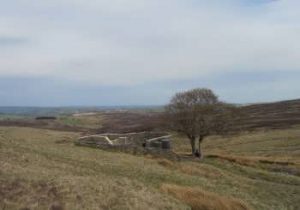 On my birthday we walked from Haworth back to Hebden Bridge via Top Withens (Wuthering Heights to you and me!) on the kind of foggy day that just makes you want to write intensely passionate and romantic poetry (although I was slightly distracted by the fact that I’d turned my left eye into a giant purple puffball by picking a mushroom, trying to identify it and then rubbing my eye…)
On my birthday we walked from Haworth back to Hebden Bridge via Top Withens (Wuthering Heights to you and me!) on the kind of foggy day that just makes you want to write intensely passionate and romantic poetry (although I was slightly distracted by the fact that I’d turned my left eye into a giant purple puffball by picking a mushroom, trying to identify it and then rubbing my eye…) We also had a rather more up-to-date and positively post-apocalyptic experience that week when we went to the fantastic Trades Club on Hallowe’en to see a screening of Last Man on Earth, a schlocky B-movie made in Italy at the height of the horror era in 1968 (adapted from Richard Matheson’s novel I Am Legend and remade under this title in 2007 with Will Smith. There’s also a 1971 remake, The Omega Man, starring Charlton Heston). It stars Vincent Price as Dr Robert Morgan who wakes every morning in his garlic- festooned house to go vampire hunting (the film’s baddies are a confusing mix of zombie and vampire). The screening was accompanied with live music from Animat who used a mixture of their own brand of dubby downtempo music as well as an eclectic selection of tracks from their DJ archive including, inevitably, Thriller! Holme Street, where the Trades Club is situated, is a cul-de-sac T-junctioned by the Rochdale Canal and it tends to attract all sorts at night… We emerged into the darkness to be met by a ragged bunch of men staggering around in an inarticulate manner with an excitable black dog, echoing the repeated scenes in The Last Man on Earth where Vincent Price encounters angry zombies every morning when he opens his door and he even inadvertently adopts a zombie dog (black, of course!).
We also had a rather more up-to-date and positively post-apocalyptic experience that week when we went to the fantastic Trades Club on Hallowe’en to see a screening of Last Man on Earth, a schlocky B-movie made in Italy at the height of the horror era in 1968 (adapted from Richard Matheson’s novel I Am Legend and remade under this title in 2007 with Will Smith. There’s also a 1971 remake, The Omega Man, starring Charlton Heston). It stars Vincent Price as Dr Robert Morgan who wakes every morning in his garlic- festooned house to go vampire hunting (the film’s baddies are a confusing mix of zombie and vampire). The screening was accompanied with live music from Animat who used a mixture of their own brand of dubby downtempo music as well as an eclectic selection of tracks from their DJ archive including, inevitably, Thriller! Holme Street, where the Trades Club is situated, is a cul-de-sac T-junctioned by the Rochdale Canal and it tends to attract all sorts at night… We emerged into the darkness to be met by a ragged bunch of men staggering around in an inarticulate manner with an excitable black dog, echoing the repeated scenes in The Last Man on Earth where Vincent Price encounters angry zombies every morning when he opens his door and he even inadvertently adopts a zombie dog (black, of course!). My visit this time was tinged with sadness, but also admiration. The effect of the Boxing Day floods last year are still very much in evidence. It has taken so long for many of the shops and houses to dry out that building and repair work has only just begun. I was delighted to see that favourite bookshop The Book Case had re-opened, but shocked to see that their floodmarker for December 2015 was level with my eyebrows… Overall, the atmosphere was positive and forward-looking, these people are tough and tenacious and their refusal to be defeated by overwhelming odds moved me considerably.
My visit this time was tinged with sadness, but also admiration. The effect of the Boxing Day floods last year are still very much in evidence. It has taken so long for many of the shops and houses to dry out that building and repair work has only just begun. I was delighted to see that favourite bookshop The Book Case had re-opened, but shocked to see that their floodmarker for December 2015 was level with my eyebrows… Overall, the atmosphere was positive and forward-looking, these people are tough and tenacious and their refusal to be defeated by overwhelming odds moved me considerably. So, finally, our quest to be the geekiest of third-wave coffee seekers scaled new heights this summer as I dropped in to the wonderful and aromatic Caravan (
So, finally, our quest to be the geekiest of third-wave coffee seekers scaled new heights this summer as I dropped in to the wonderful and aromatic Caravan (